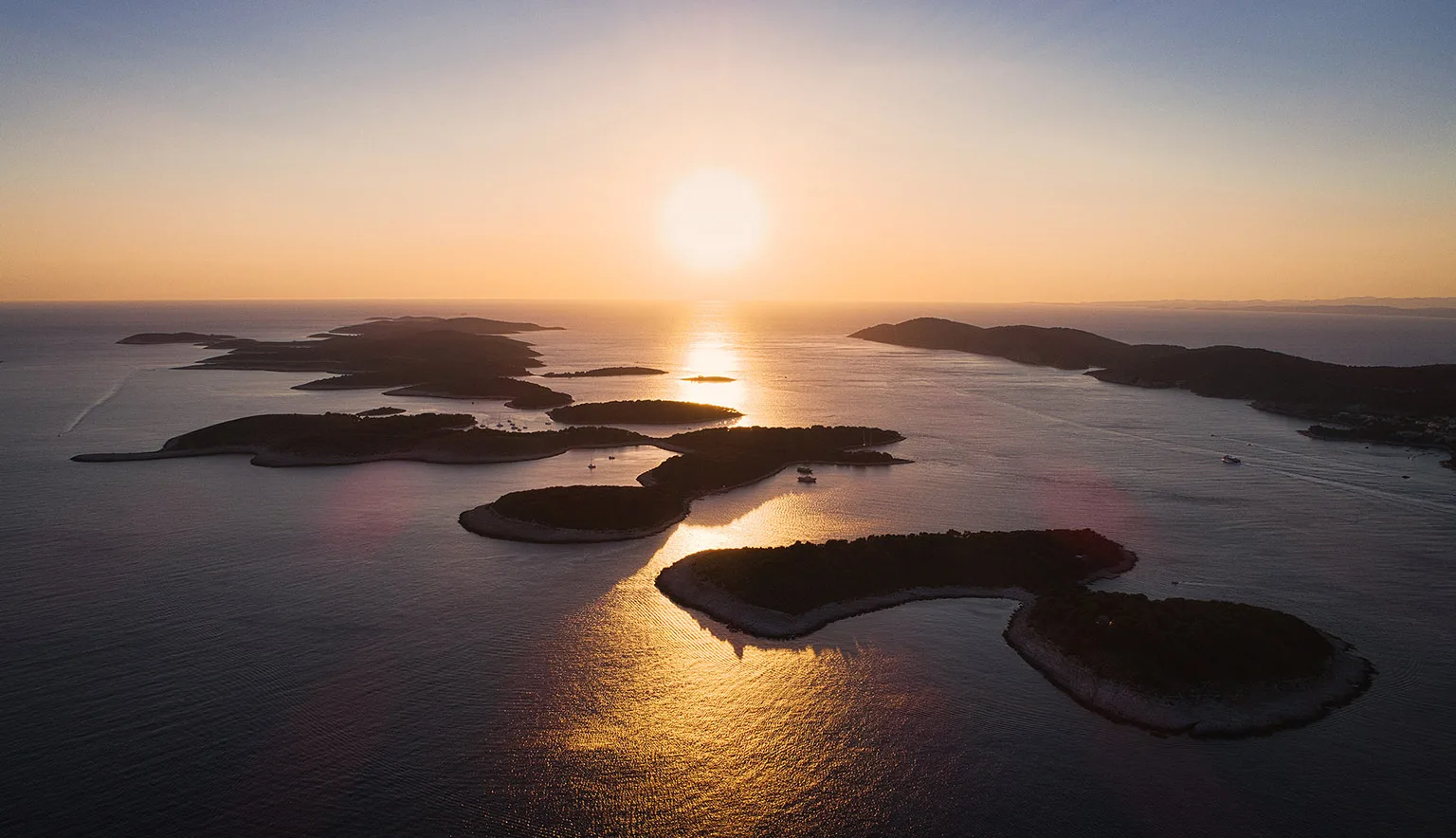Crystal-clear waters, historic charm, and vibrant nightlife combine to present Hvar as an essential Mediterranean getaway. Located along Croatia’s Dalmatian coast, the island is a blend of both natural beauty and cultural allure.
HVAR
Set in the sparkling Adriatic Sea off the coast of Croatia, Hvar is where history, luxury, and adventure converge.
Known for its mild climate, lush vineyards, and ancient towns, the island has become a sought-after destination for travellers seeking both relaxation and cultural enrichment.
Diverse landscapes, from rocky coves and pine-fringed beaches to verdant hills and scenic coastal paths, present Hvar as an ideal site for exploration and discovery.
The island’s history is just as enchanting as its landscapes, speckled with antiquity, such as the 16th-century Fortica Fortress, the Gothic-style St. Stephen’s Cathedral, and rustic villages showcasing traditional Croatian architecture.
Hvar Town, meanwhile, exudes a blend of old-world charm and modern luxury where visitors can find everything from ancient, cobbled streets to high-end boutiques and waterfront restaurants serving local wines and fresh seafood.
After sunset, the town’s cafés, beach bars, and clubs pulse with energy, drawing a mix of international visitors and locals to its vibrant nightlife and scenic harbour.
For a quieter evening experience, nearby towns like Stari Grad and Jelsa offer a more relaxed atmosphere with charming cafés and family-owned wineries.
Adventure-seekers can relish in a variety of exciting activities, from sailing around the nearby Pakleni Islands to scuba diving in crystal-clear waters or hiking through lush vineyards.
In essence, Hvar is a multifaceted destination offering history, culture, and nature against a backdrop of unparalleled Mediterranean beauty, making for a stimulating yet laid-back island escape.
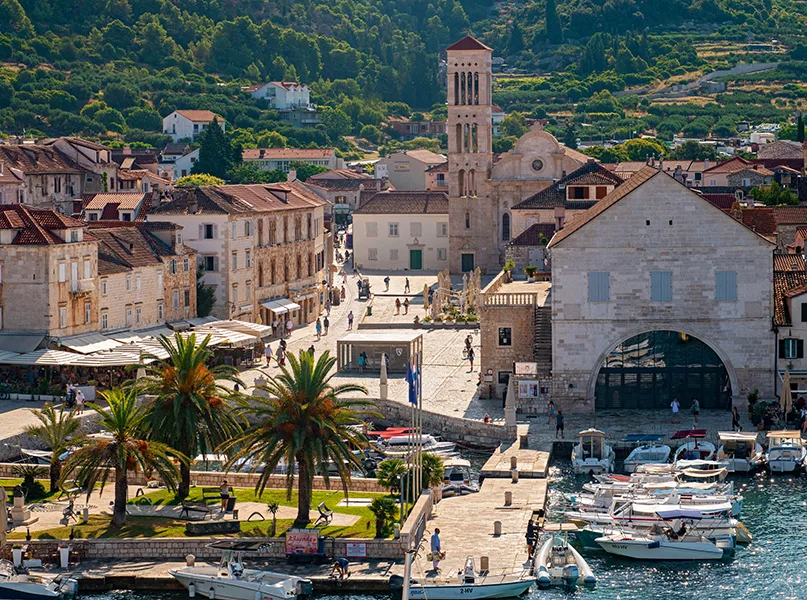
Q&A WITH HVAR TOWN TOURIST BOARD
Iva Belaj Šantić, Director of the Hvar Town Tourist Board, outlines the rich history of tourism on the island, the countless visitor experiences on offer, and the organisation’s role in navigating a sustainable future for the industry.
In your opinion, why should someone visit Hvar?
Iva Belaj Šantić, Director (IBS): Hvar is where time seems to slow down, allowing you to relax and savour every moment. There’s no rush here – everything you need is patiently waiting for you.
The sun, which shines nearly all year round, beautiful beaches, some of which are still secret, rich gastronomy bursting with flavour, and countless opportunities for excursions make Hvar an ideal escape from the everyday.
If you’re looking for a unique island with great energy, rich history, delicious food, and friendly people, look no further.
As an organisation with many years of experience in the local tourism industry, how would you say Hvar has evolved as a destination?
IBS: Traces of visitors to Hvar date back to as early as 2407 BCE when the Greeks colonised Pharos, making the island a hub of cultural and trade connections.
Over centuries, others followed, including pilgrims on their way to the holy land and, during winter, Venetian ships seeking safe harbour. These visitors brought new ideas, spices, and influences from distant lands, enriching the island’s heritage.
The modern era of tourism began in 1868 with the founding of the Hvar Hygienic Society (Societa Igienica), which functioned much like the Hvar Tourist Board today, promoting the island as a winter health resort due to its mild climate and therapeutic benefits. This was the first institution of its kind in Europe.
Since then, Hvar has evolved into a destination for sun seekers, luxury travellers, and outdoor enthusiasts, offering a mix of history, culture, and adventure, and welcoming visitors from all around the world.
“If you’re looking for a unique island with great energy, rich history, delicious food, and friendly people, look no further”
Iva Belaj Šantić, Director, Hvar Town Tourist Board
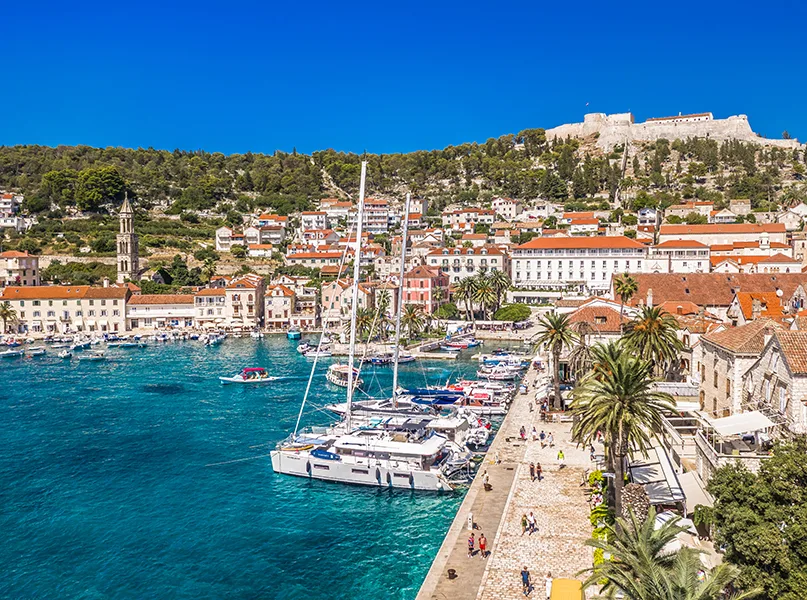
With a history dating back to the 4th century BCE, what important historical and cultural landmarks can tourists encounter on the island?
IBS: Hvar is the only Croatian island with six UNESCO-listed assets.
But that’s not all! Hvar is a treasure trove of history and culture at every step, from ancient artefacts to ceramic depictions uncovered in Grapčeva Cave, one of which is believed to be the oldest-ever portrayal of a ship.
Hvar also boasts the historic St. Stephen’s Square (Pjaca), the largest in Dalmatia, where visitors can discover the Arsenal building and the oldest public theatre in Europe, founded in 1612. Meanwhile, the stunning Fortica Fortress offers breathtaking views of the surrounding landscape.
The nearby Pakleni Islands feature pristine beaches, perfect for a relaxing getaway, whilst the ancient town of Stari Grad showcases remarkable Greek influence, a testament to its rich history.
Elsewhere, the charming town of Jelsa and village of Vrboska further enrich Hvar’s unique character and spirit with stories about great wineries and the lives of winemakers and fishermen.
How do you market and promote Hvar’s various travel offerings to both domestic and international tourists?
IBS: We market Hvar as a unique destination and an island of a thousand stories. We utilise both digital and traditional marketing channels to promote Hvar, showcasing its stunning natural beauty, crystal-clear seas, and abundant sunshine.
Emphasising the island’s rich cultural heritage alongside its modern amenities, safety, and leisure opportunities is key.
Sustainable tourism practices are particularly important to us, especially those that respect the local community. Whilst Hvar is a popular tourist destination, it is also where we live and raise our children, and we want to highlight this to visitors.
Our primary goal is to reach international audiences who may not be familiar with Hvar or who have never had the chance to visit. To achieve this, we collaborate with representatives on familiarisation trips, partner with travel agencies, engage with social media influencers, and participate in tourism fairs worldwide.
Through these efforts, we aim to showcase Hvar in a way that makes a lasting impression and holds a special place in visitors’ hearts.
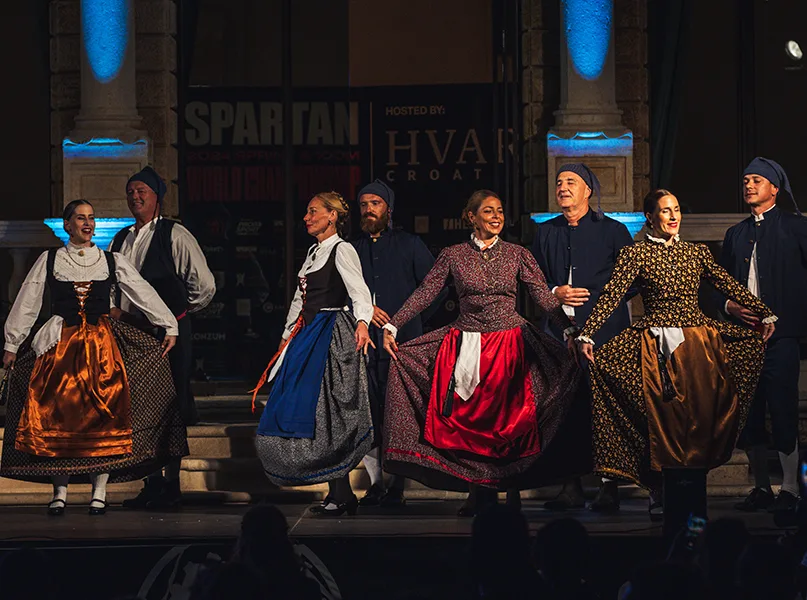
As a culturally vibrant destination with a busy events calendar, what type of travellers does Hvar typically attract?
IBS: While Hvar has often been associated with nightlife, it is so much more than just a party destination, and we strive to emphasise this.
Hvar attracts a diverse range of travellers, including history buffs, culture vultures, nature lovers, and luxury tourists. With its UNESCO-listed assets and vibrant events, the island appeals to those looking for both relaxation and cultural enrichment.
Hvar’s calendar is filled with events catering to various interests, such as the Hvar Summer Festival, which features concerts, performances, and exhibitions.
Families can enjoy summer on the island with their children, whilst sports enthusiasts can participate in events like the Hvar Half Marathon, Spartan Sprint World Championship, or the Melges 24 and New Year Regatta boat races.
Additional sports events include the European Veteran Judo Cup and Hvar International Open Chess Tournament, catering to a wide range of sports interests.
Art lovers can engage with creative initiatives like Sketchbook by the Sea or our Bodypainting Festival, film buffs can watch a movie at Kino Mediteran, whilst local events such as the Jelsa Wine Festival and Dani U Vali Festival (Days in the Bay) in Stari Grad provide a taste of local culture and tradition.
With a rich variety of activities, Hvar Town and the surrounding areas are brimming with opportunity, ensuring visitors can find experiences that resonate with their interests. Our focus is on creating a vibrant atmosphere that balances entertainment with cultural experiences, making Hvar a perfect destination for creating unforgettable memories.
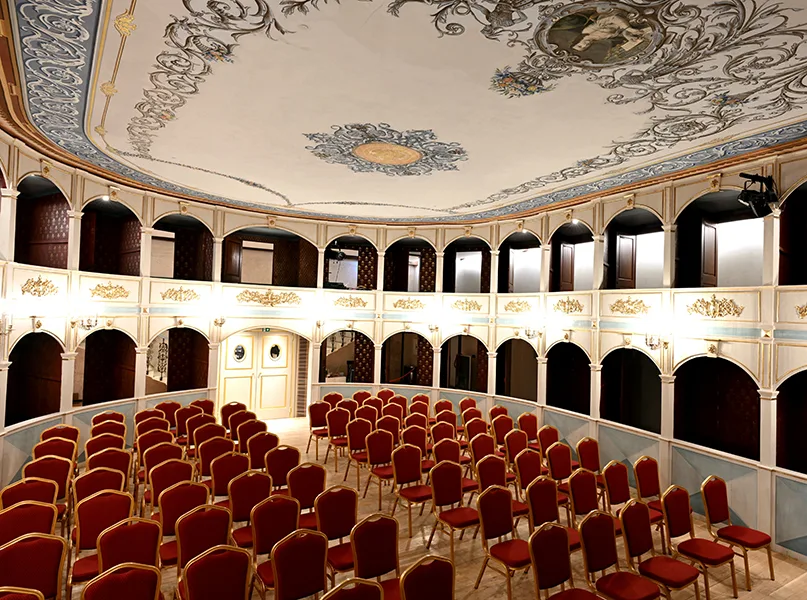
How does Hvar appeal to travellers in all four seasons of the year?
IBS: Hvar is often considered a summer destination, but it holds year-round appeal, even if it is much quieter during the off-season.
In spring and autumn, the mild weather is ideal for outdoor activities such as hiking, cycling, and wine tasting.
Winter brings a more peaceful atmosphere, with reduced transport connections between November and March and most tourist-oriented businesses closed. This is the islanders’ time, and while you may not find much in terms of services, you might just find something even more valuable – yourself.
The off-season allows both the locals and nature to regenerate. It’s a time when Hvar truly breathes, offering a rare and personal experience that the busy summer months can’t provide. You can explore the island’s charm at your own pace – after all, tourism in Hvar began as a winter escape, and perhaps it’s time to reconnect with those origins.
For modern nomads, this tranquil period is ideal as the slower pace and natural beauty make Hvar a perfect place for remote work, reflection, and reconnecting with nature.
How important are the awards and accolades the Hvar Tourist Board has accumulated over the years?
IBS: Hvar has consistently garnered international recognition as a premier destination in Europe and worldwide.
In 2024, Travel + Leisure honoured Hvar with third place in Europe and seventh globally in its World’s Best Awards, whilst Condé Nast Traveller readers ranked it amongst the top 10 islands in Europe, placing it eighth.
Wanderlust readers similarly recognised Hvar as one of Europe’s most desirable islands, ranking amongst the top five in 2024, and according to the renowned TimeOut magazine, is 2024’s fourth most beautiful island in the world.
In 2023, Big 7 Travel named Hvar the ‘Best Island in the World’, whilst Travel + Leisure and Condé Nast Traveller both ranked it highly for its beaches, charm, and appeal.
This pattern of accolades stretches way back, including a first-place ranking as Europe’s best island by Condé Nast Traveller in 2019 and 2021, respectively, reflecting Hvar’s enduring allure.
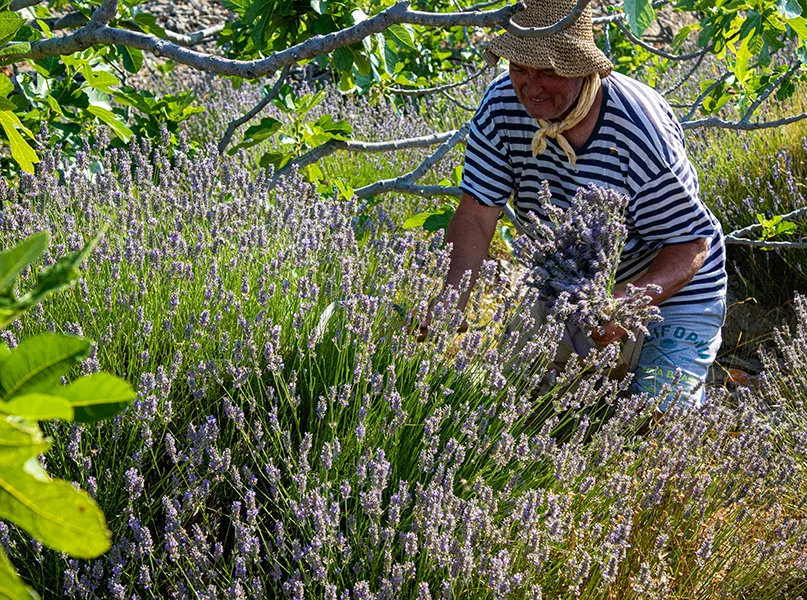
What other cultural, historical, or sporting activities attract visitors to Hvar?
IBS: Besides the cultural and historical attractions I’ve already mentioned, Hvar offers a variety of outdoor activities that are perfect for adventure seekers. Thanks to the island’s stunning natural landscapes, hiking, sailing, diving, and cycling are popular, as well as rock climbing.
What makes Hvar truly unique is its seamless blend of cultural richness and outdoor experiences. Whether exploring ancient landmarks or enjoying exhilarating activities, the island offers an unmatched combination of history, culture, and adventure.
Finally, are you optimistic about the future of the tourism industry in Hvar?
IBS: We live in a time when travel has become easier and more accessible than ever, allowing people from all over the world to experience the beauty of places like Hvar.
Whilst this newfound accessibility brings incredible opportunities, it also presents challenges with managing tourism sustainably. As an island with a sensitive ecosystem and a tourism-focused economy, Hvar must navigate these pressures carefully. Still, I remain hopeful for Hvar’s future.
In the coming years, we have an opportunity to harmonise the quality of life for our internal communities with the experiences of visitors who choose Hvar for their precious vacation time.
Our vision increasingly centres around sustainable and regenerative tourism – building a model that not only enhances the visitor experience but also supports local culture, community, and nature.
Enjoying over 155 years of tourism, Hvar can draw on its long-standing role as a model destination to create a balanced approach that honours both tradition and progress.
Looking ahead, I trust that the sun, the essence of the island, will continue to shine brightly on Hvar.
In the opinion of locals, and with recognition from Condé Nast Traveller, Travel + Leisure, Wanderlust, and more, Hvar stands among the world’s most beautiful islands.
Visit Hvar. Feel Hvar. Love Hvar.
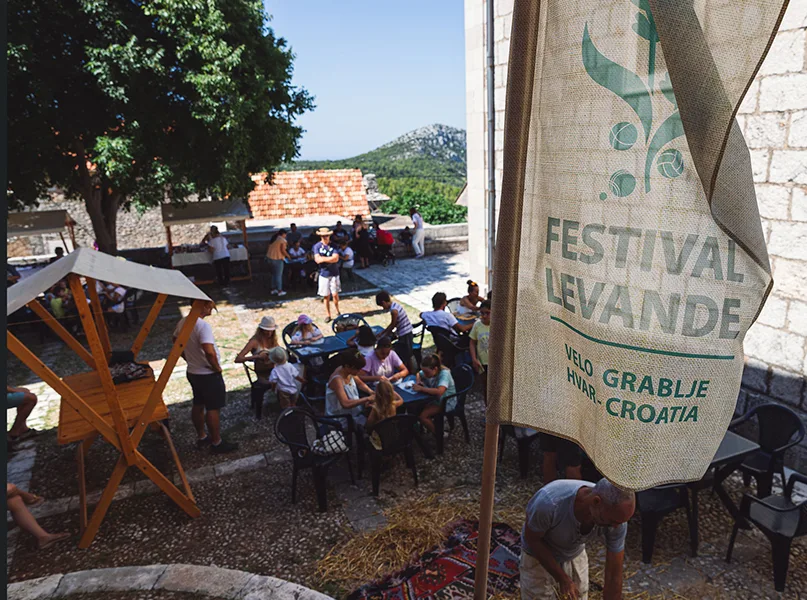
OUTLOOK RECOMMENDS
Eat:
FOR TANTILISING TASTING NOTES…
Explore Vina Tomić, where endless grape varieties, a steady climate, and years of expertise are the perfect recipe for unforgettable wine. Owner, Andro Tomić, has dedicated his life to wine and oenology, today producing up to 150,000 bottles per year from his vineyard. Extensive wine tasting programmes are on offer, accompanied by Croatian delicacies such as prosciutto, cheese, and olive oil. Vina Tomić’s most popular bottle, the Plavac Mali, is a must-try for connoisseurs.
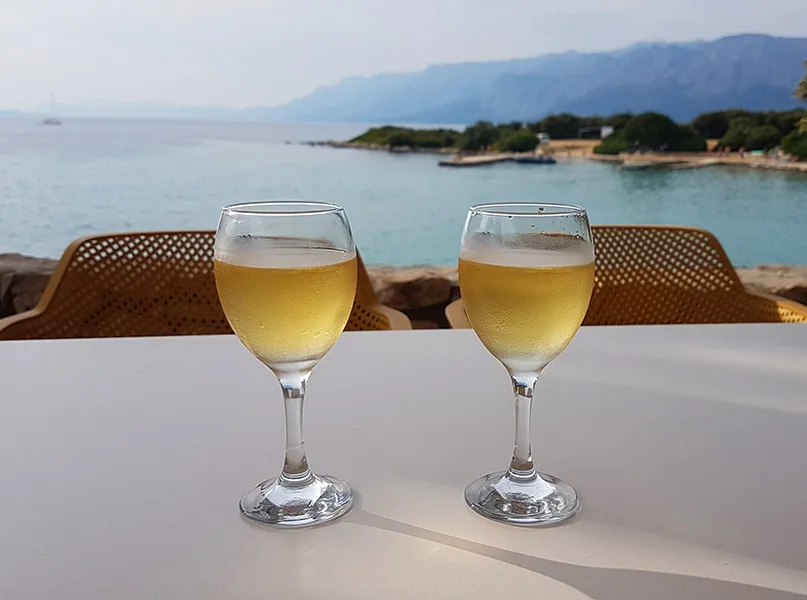
FOR TRADITIONAL CUISINE…
Visit Giaxa in Hvar Town to sample the island’s signature dish of gregada – a fragrant stew comprising white fish, potatoes, onions, garlic, and local olive oil. Housed in a 15th century, Late Gothic-style Venetian palace, the restaurant boasts a storied past. Offering three-course tasting menus from the freshest seasonal ingredients and baking its own bread, this carefully curated culinary gem is not to be missed.

Do:
FOR A FRAGRANT FORAY…
Known as ‘Lavender Island’ by many, Hvar is home to endless rolling lilac hills during the early summer months when the quaint villages of Zastražišće, Gdinj, and Bogomolje enjoy a sea breeze infused with the soothing scent of lavender. A testament to the island’s agricultural legacy, the lavender fields are best enjoyed in June or July for a particularly aromatic experience.

FOR AN INSIGHTFUL DEEP DIVE…
Explore the Paulina shipwreck, a sunken English merchant ship dating back around 150 years. Residing 30 metres below sea level, the wooden vessel houses John Dories and conger eels and is covered by vibrant yellow sea sponges. Guided tours are available to discover the diverse marine wildlife and uncover the histories of this wreck’s storied past.
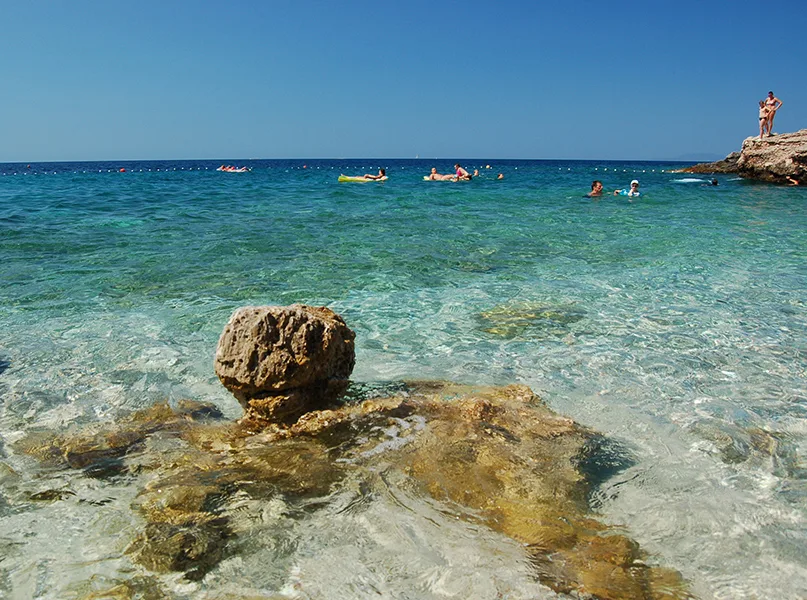
Sleep:
FOR A PEACEFUL ESCAPE…
Cast Away offers the opportunity to relax and unwind in a stunning seafront location. Located close to the remote village of Gromin Dolac in the south of Hvar, this scenic resort offers 10 spacious beach huts equipped with comfortable facilities and endless views of the Adriatic Sea. Escape the hustle and bustle and relax in one of the resort’s hammocks as the gentle waves ebb and flow.
FOR FIRST-CLASS INDULGENCE…
Whether participating in pampering spa treatments or indulging at the pool bar, Hotel Moeesy, Blue & Green Oasis is a serene utopia that truly represents luxury. Those seeking an adventure can partake in nearby scuba diving, snorkelling, and body surfing, whilst the hotel’s promenade by the sea presents breathtaking views. Meanwhile, the resort’s innovative use of solar panels guarantees an eco-conscious stay.
HVAR’S UNESCO-LISTED ASSETS IN FOCUS
Well-known for its natural, cultural, and historical significance, Hvar is home to no less than five UNESCO Intangible Cultural Heritage-listed traditions and practices.
Za Križen, or ‘Following the Cross’, is a profoundly religious celebration that showcases the island’s rich traditions and beliefs, attracting many participants and visitors during the Easter season. Dating back to the 16th century, the procession passes through Hvar’s main towns, led by a cross-bearer.
The island’s lace-making technique, meanwhile, is practised exclusively by the Benedictine sisters of Hvar Town and involves creating intricate lace from agave plant leaf fibres. A traditional craft that originated over 130 years ago, large pieces can take between five and six months to complete due to their unique designs.
Then there’s Hvar’s traditional construction technique, dry stone walling, which creates the island’s characteristic ‘stone lace’, contributing to its picturesque landscapes. This method is typically used to create pens for livestock and is an essential component of the island’s cultural identity.
More than just food, the Mediterranean diet of Hvar also encompasses a way of life and rich cultural traditions. Dating back centuries, fresh seafood, fruit, and vegetables, alongside carefully produced wines, play an important part in the Dalmatian diet.
Last but not least, traditional klapa singing resonates deeply with the island’s spirit and is typically performed a cappella. Expressing the cultural identity of the entire Dalmatian region, klapa songs can be distinguished by their musical and lyrical content, whilst singers perform standing in a tight semicircle.
In addition, Stari Grad Plain, also known as Ager, is the island’s only UNESCO World Heritage Site. The unique plain has remained largely untouched since 384 BCE when the island was colonised by ancient Greece. An archaic agricultural landscape that narrates Hvar’s storied past, the plain features ancient stone walls and a geometrical system of land division, thought to be tangible evidence of Greek influence.
LANDMARK ATTRACTIONS
Fortica Fortress
Perched high above Hvar Town, Fortica Fortress offers sweeping views over the Adriatic Sea and nearby islands. Built in the 16th century, this historic stronghold provides a glimpse into Hvar’s defensive past with its ancient walls, storied battlements, and striking panoramic lookouts.
Pokonji Dol Lighthouse
A scenic boat ride to Pokonji Dol Lighthouse takes you along a rugged coastline and vibrant Mediterranean landscapes. As one of Hvar’s most iconic coastal landmarks, the lighthouse looms over turquoise waters and pebble beaches, offering a rewarding vista for those who embark on the journey.
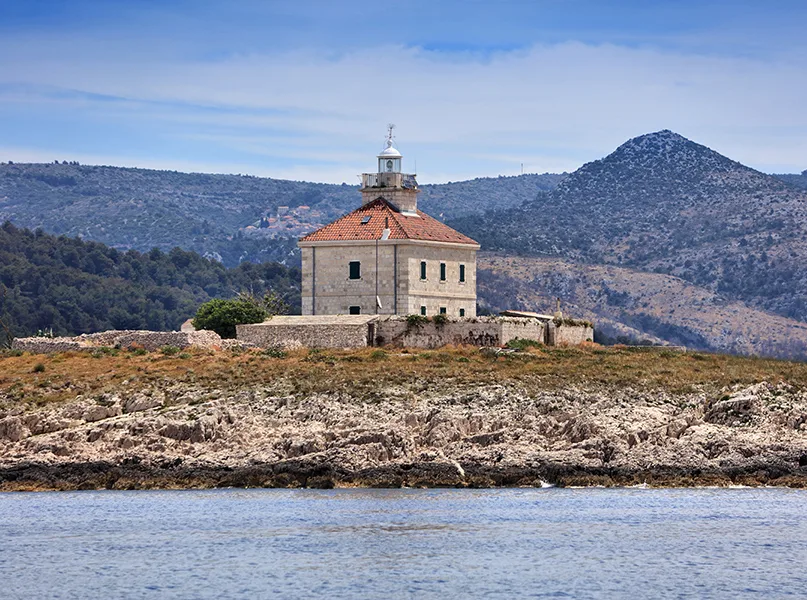
Pakleni Islands
Just a short boat ride from Hvar, the Pakleni Islands are an enchanting archipelago with secluded beaches, azure waters, and hidden coves. Ideal for snorkelling, sunbathing, or exploring by kayak, the islands combine natural beauty and tranquillity, making them an idyllic escape from bustling Hvar Town.
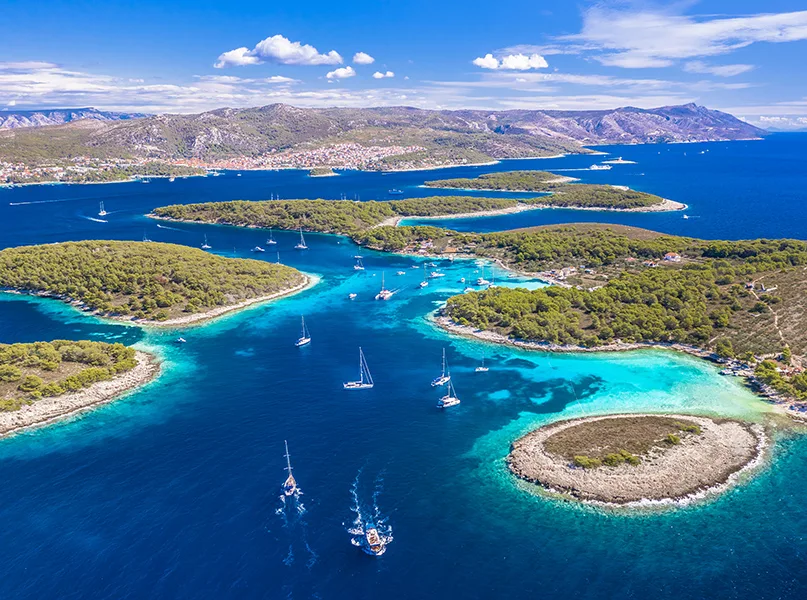
GETTING THERE AND AROUND
Hvar is accessible from major international destinations and is well-connected domestically.
To reach the destination from around the globe, travellers can fly into Split Airport (SPU), which offers year-round services from major European hubs such as London, Paris, and Frankfurt, alongside seasonal routes from North America and Asia.
From Split, a convenient ferry or catamaran service providing direct access to Hvar runs frequently during the summer months, taking approximately one to two hours to reach the island depending on the route.
For those arriving in Croatia by road, Split is easily reached via the country’s A1 motorway, which runs along the Adriatic coastline. From here, travellers can utilise daily car ferries that dock in Stari Grad.
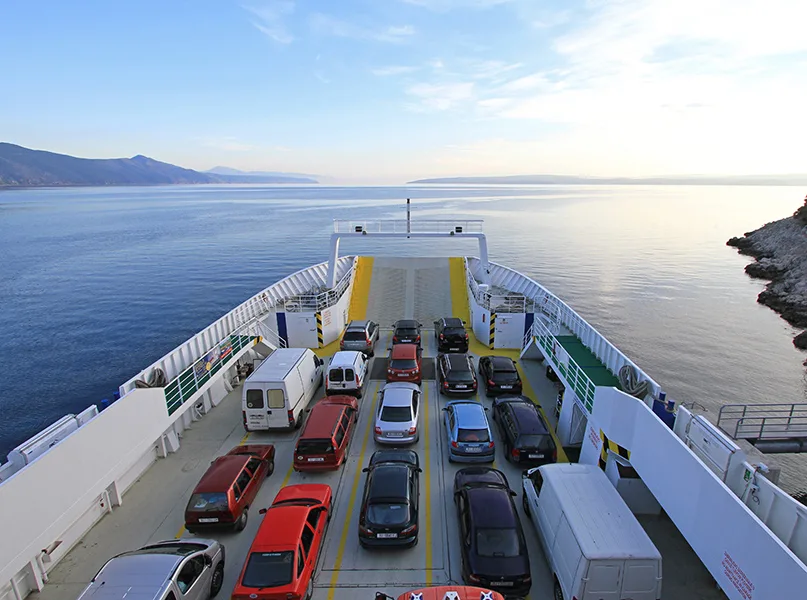
Upon arrival, navigating Hvar is straightforward with public buses connecting major hubs such as Hvar Town, Stari Grad, and Jelsa, offering an affordable and scenic way to get around the island. However, renting a car, scooter, or bicycle can provide visitors with greater flexibility alongside access to the secluded beaches and inland villages unreachable by public transport.
Taxis are readily available across Hvar’s main towns and ports, while private boat rentals offer an unforgettable way to explore the island’s surrounding coves and nearby Pakleni Islands.
In terms of accessibility, some beaches have introduced accessible ramps, pathways, and beach chairs for wheelchair users, whilst public buses are increasingly equipped with ramps for disabled access.
In short, the island’s transportation options seek to make the destination an easily navigable paradise for all.


